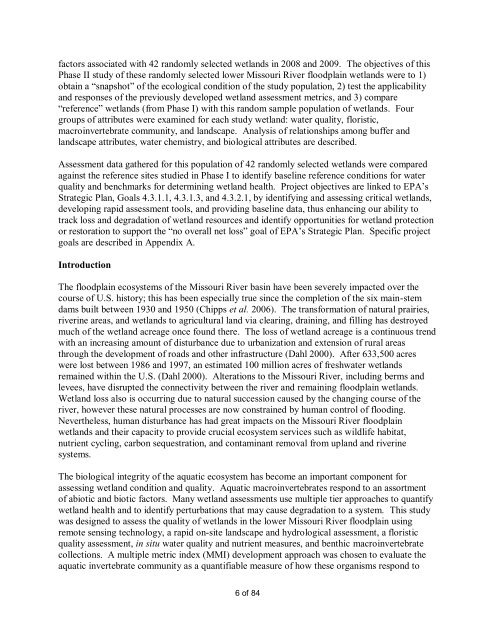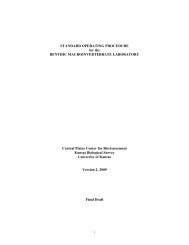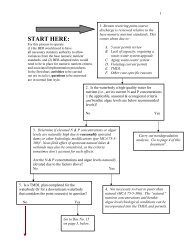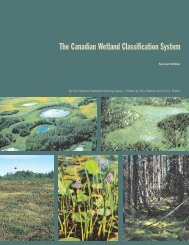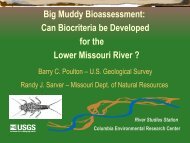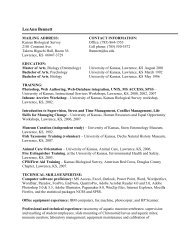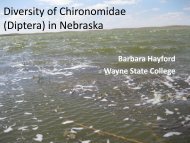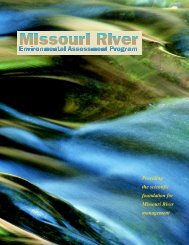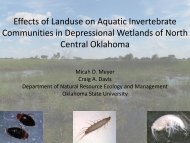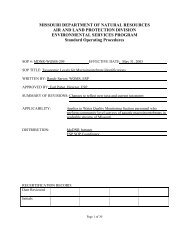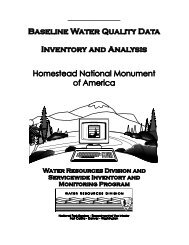Koontz, J., D.G. Huggins, C.C. Freeman, D.S. Baker - Central Plains ...
Koontz, J., D.G. Huggins, C.C. Freeman, D.S. Baker - Central Plains ...
Koontz, J., D.G. Huggins, C.C. Freeman, D.S. Baker - Central Plains ...
You also want an ePaper? Increase the reach of your titles
YUMPU automatically turns print PDFs into web optimized ePapers that Google loves.
factors associated with 42 randomly selected wetlands in 2008 and 2009. The objectives of this<br />
Phase II study of these randomly selected lower Missouri River floodplain wetlands were to 1)<br />
obtain a “snapshot” of the ecological condition of the study population, 2) test the applicability<br />
and responses of the previously developed wetland assessment metrics, and 3) compare<br />
“reference” wetlands (from Phase I) with this random sample population of wetlands. Four<br />
groups of attributes were examined for each study wetland: water quality, floristic,<br />
macroinvertebrate community, and landscape. Analysis of relationships among buffer and<br />
landscape attributes, water chemistry, and biological attributes are described.<br />
Assessment data gathered for this population of 42 randomly selected wetlands were compared<br />
against the reference sites studied in Phase I to identify baseline reference conditions for water<br />
quality and benchmarks for determining wetland health. Project objectives are linked to EPA‟s<br />
Strategic Plan, Goals 4.3.1.1, 4.3.1.3, and 4.3.2.1, by identifying and assessing critical wetlands,<br />
developing rapid assessment tools, and providing baseline data, thus enhancing our ability to<br />
track loss and degradation of wetland resources and identify opportunities for wetland protection<br />
or restoration to support the “no overall net loss” goal of EPA‟s Strategic Plan. Specific project<br />
goals are described in Appendix A.<br />
Introduction<br />
The floodplain ecosystems of the Missouri River basin have been severely impacted over the<br />
course of U.S. history; this has been especially true since the completion of the six main-stem<br />
dams built between 1930 and 1950 (Chipps et al. 2006). The transformation of natural prairies,<br />
riverine areas, and wetlands to agricultural land via clearing, draining, and filling has destroyed<br />
much of the wetland acreage once found there. The loss of wetland acreage is a continuous trend<br />
with an increasing amount of disturbance due to urbanization and extension of rural areas<br />
through the development of roads and other infrastructure (Dahl 2000). After 633,500 acres<br />
were lost between 1986 and 1997, an estimated 100 million acres of freshwater wetlands<br />
remained within the U.S. (Dahl 2000). Alterations to the Missouri River, including berms and<br />
levees, have disrupted the connectivity between the river and remaining floodplain wetlands.<br />
Wetland loss also is occurring due to natural succession caused by the changing course of the<br />
river, however these natural processes are now constrained by human control of flooding.<br />
Nevertheless, human disturbance has had great impacts on the Missouri River floodplain<br />
wetlands and their capacity to provide crucial ecosystem services such as wildlife habitat,<br />
nutrient cycling, carbon sequestration, and contaminant removal from upland and riverine<br />
systems.<br />
The biological integrity of the aquatic ecosystem has become an important component for<br />
assessing wetland condition and quality. Aquatic macroinvertebrates respond to an assortment<br />
of abiotic and biotic factors. Many wetland assessments use multiple tier approaches to quantify<br />
wetland health and to identify perturbations that may cause degradation to a system. This study<br />
was designed to assess the quality of wetlands in the lower Missouri River floodplain using<br />
remote sensing technology, a rapid on-site landscape and hydrological assessment, a floristic<br />
quality assessment, in situ water quality and nutrient measures, and benthic macroinvertebrate<br />
collections. A multiple metric index (MMI) development approach was chosen to evaluate the<br />
aquatic invertebrate community as a quantifiable measure of how these organisms respond to<br />
6 of 84


